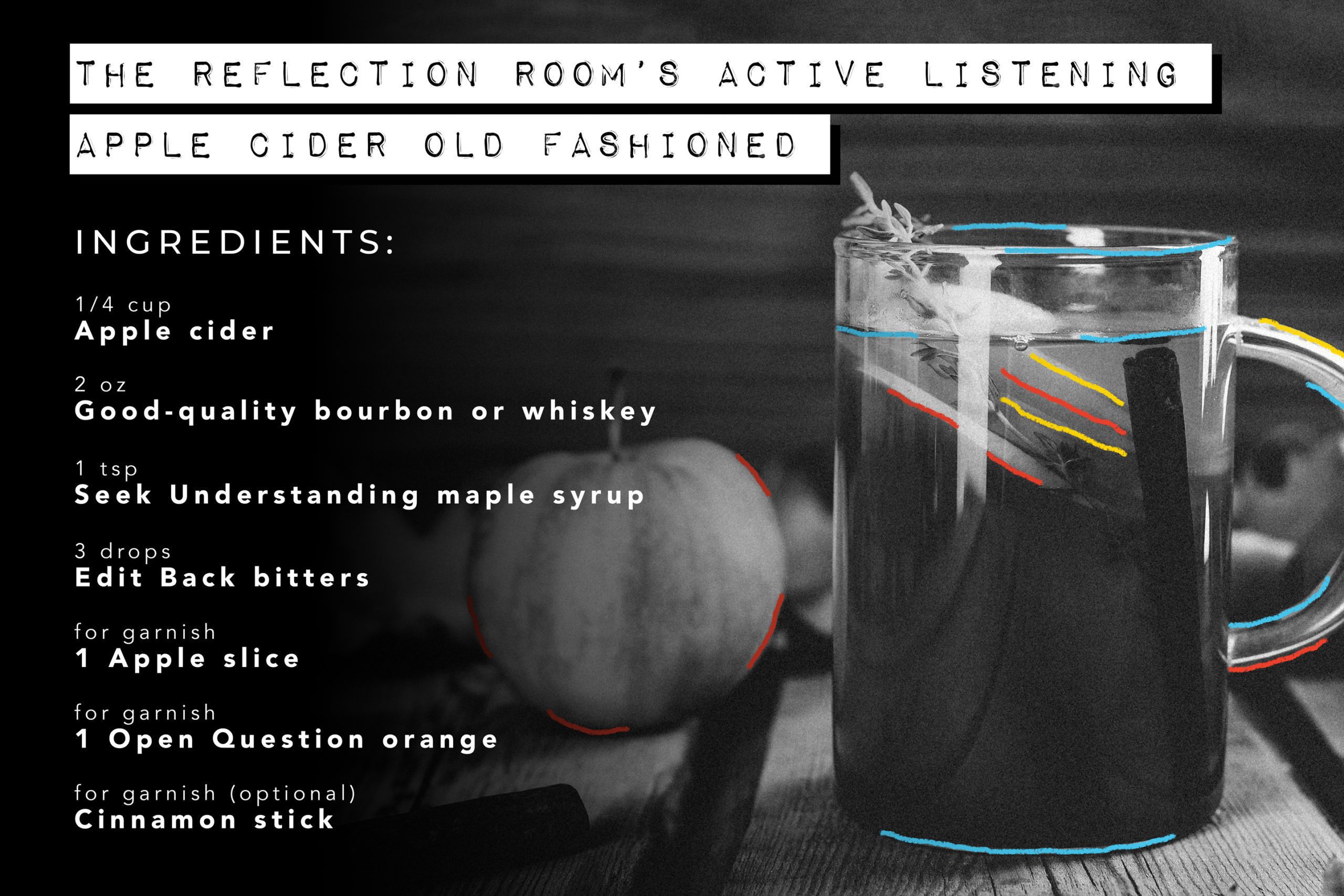Coming together to reflect can be a powerful tool for any team, especially when you’re planning for the coming year. To make your year-end meeting truly impactful, bringing in every voice in the room, you have to actively listen. This November we’re taking you to the Reflection Room for an Active Listening Apple Cider Old Fashioned. No one has ever learned anything while talking, so zip your lip and sip your drink.

Step 1: In a lowball glass, stir together the apple cider, whiskey, and Seek Understanding maple syrup.
Active listening isn’t just a tool, but a mindset. When you use it in a conversation, the higher purpose is to seek understanding. So what does that actually mean?
There are levels of listening.
Most of us hover between one and three. We listen to respond or receive information. If we want to create connection, we actually have to listen to understand; understand the other person’s content, emotions, or even just them as a whole.
Here’s an example of listening to give information, where we think we’re connecting but we’re actually not.
- Coworker A: “What did you do this weekend?”
- Coworker B: “I tried hiking a new trail near my house this weekend. It was 5 miles, but I’m hoping to be able to do 10 in the next few months.”
- Coworker A: “That’s great! I love hiking too. I recently hiked B.S. Mountain it was pretty tough.”
- Coworker B: “Oh yeah I’ve heard that mountain is pretty tough.”
Instead of keeping the discussion about Coworker B, Coworker A honed in on one thing Coworker B said and shared their own story related to it, shifting the focus of the conversation.
Most of us do this, we want to relate, but that’s hurting our ability to learn AND to understand. Coworker A stopped the conversation before they could learn more.
So how do you listen to understand? Start with an edit back.
Step 2: Add your Edit Back Bitters.
An edit back has many names: playback, rephrase, paraphrase, check for understanding.
The edit back is a concise summary of what the other person said. In our earlier example, it would look something like this.
- Coworker A: “What did you do this weekend?”
- Coworker B: “I tried hiking a new trail near my house this weekend. It was 5 miles, but I’m hoping to be able to do 10 in the next few months.”
- Coworker A: “You hiked a new 5-mile trail and you’re hoping to do a 10-mile one in the coming months.”
- Coworker B: “Yeah! One of my goals this year is to hike XYZ mountain which is 15 miles. I’m slowly working my way up. Every weekend I try to do a minimum of five miles.”
By editing back, Coworker A was able to learn more about Coworker B. Instead of just learning about what Coworker B did this past weekend, they learned that Coworker B has a goal this year to hike XYZ mountain and they hike every weekend to prepare for it.
By maintaining focus on Coworker B with the Edit Back, Coworker A gained a better understanding of Coworker B.
HOMEWORK: In the next conversation you have, when someone else is speaking, try the edit back. It can be short and simple. Even a few words are enough. It may feel or seem repetitive to you, but it won’t to the other person (we promise, just give it a try).
Step 3: Add your garnishes, including your Open Question Orange slice.
After an edit back you’ll get one of three responses:
- Confirmation – “Yes.”
- Continuation – “Yes and….”
- Correction – “Actually I meant…”
With a continuation and correction, the person you’re listening to will give you more content to edit back. But what if they give you a confirmation and then just stop? Use an open question:
– Tell me more.
– What’s an example of that?
– Why do you say that?
– What else should I know?
Open questions open the floor for the person you’re listening to, to share more information, but they don’t steer the conversation in a particular direction.
Use open questions early on in a conversation when you’re gathering information. As you uncover more and more details, you can start to ask more specific questions. Ultimately open questions give the person you’re listening to the ability to lead the conversation where they want it to go.
With drink in hand, you’re ready for your end-of-year meetings.
Active Listening is an important tool for reflecting as a team. You learn more about everyone’s perspectives and create a better, more thoughtful action plan because of it. Create space for your team. Connect with your team. Start actively listening.
Want to hear more about active listening?
Here’s what our VP Jessica Thrasher has to say:
Check out our other Winning Ingredients blogs for successful leadership recipes.